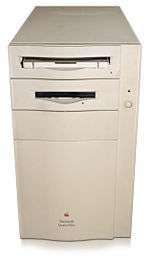Macintosh Quadra 840AV
 | |
| Release date | July 29, 1993 |
|---|---|
| Introductory price | 3500 |
| Discontinued | July 18, 1994 |
| Operating system | System 7.1-System 7.1.2, System 7.5-Mac OS 8.1, or with PowerPC upgrade, Mac OS 9.1 |
| CPU | Motorola 68040 @ 40 MHz |
| Memory | 8 MiB, expandable to 128 MiB (60 ns 72-pin SIMM) |
.jpg)
The Macintosh Quadra 840AV (code names: "Quadra 1000", "Cyclone") is a personal computer that is a part of Apple Computer's Quadra series of Macintosh computers. It was introduced in July 1993 alongside the Centris 660AV, the "AV" after both model numbers signifying video input and output capabilities, as well as enhanced audio. It was discontinued in July 1994, with no immediate replacement – however, the later AV versions of the Power Macintosh 8100 took a very similar position in Apple's product lineup.
At the time of introduction, its 40 MHz Motorola 68040 CPU and interleaved RAM made it the fastest Macintosh available, topping both the nominally higher-end Quadra 950 and the Quadra 800 by 7 MHz. It remains both the fastest Quadra and the fastest 68k Macintosh of all time, since all later high-end Macintoshes were PowerPC-based Power Macintoshes. The 840AV is also the only Mac to use the 40 MHz-clocked 68040. It also sports a faster 66.7 MHz AT&T DSP 3210 Digital Signal Processor chip, compared with the 55 MHz variant in the 660AV. The on-board DSP was primarily intended to speed up audio/video processing, although few Mac programs made use of this due to the complexity of programming it.
The 840AV and its relative, the Centris/Quadra 660AV, marked a number of firsts for the Macintosh family. They were the first Macintoshes to include on-board 16-bit 48 kHz stereo audio playback and recording capability, as well as S-Video and composite video input and output. To improve video playback, two separate frame buffers were used: one for standard graphics, and one specifically for video. This enabled the live video input to be displayed as a scalable "window" within the Macintosh user interface. They were also the first personal computers that supported speech recognition (PlainTalk) out-of-the-box. The Apple GeoPort Telecom Adapter Kit introduced with the AV Macs added many DSP-based telecommunication functions, such as modem, fax, and telephony.
The Quadra 840AV came in a similar case to the earlier Macintosh Quadra 800 (the power button was moved to the front and the debugging switches were omitted). However, the 840AV was significantly different on the inside. Apart from the faster processor, it lacked the 800's Processor Direct Slot and second ADB port, but added a DAV slot (in line with NuBus slot A) and the new GeoPort. Also, unlike the 800's 8 MiB of fixed RAM on the logic board, all of the 840AV's memory was in SIMMs (this is the reason why the minimum amount of memory is lower).
Trivia

The new AV machines were some of the first to ship standard with an internal CD-ROM drive (earlier Quadra and Centris models were available with the built-in CD-ROM drive as optional extras). The Quadra 840av was the first Apple computer to come with an internal CD-ROM standard. The operating system installation package came on CD-ROM rather than a series of floppy disks whenever the CD-ROM drive was included. A hidden QuickTime video included on the original Quadra 840AV/Centris 660AV "Install Me First" CD-ROM, shows the jubilant Cyclone / Tempest design team in the midst of celebrating their accomplishment. In this video, a Cyclone (840AV) prototype logic board is shown. The logic board is fitted with a 25 MHz 68040, a number of rework wires, and most conspicuously, a daughter card nicknamed "Karma", on which the audio and video input/output ports are located. Notably, the audio and video ports on the card are front-facing, positioned as though they would protrude from an opening in the lower front of the case, where they are more easily accessible to the user. According to a member of the team, the "AV on a card" feature was omitted, because there was not enough room for it in the case. Coinciding with the introduction of both AV Macs, Apple introduced the Apple AudioVision 14 Display, featuring easily accessible audio input, audio output and video input ports of its own, which could be fed by an ADC adapter cable connected with the rear AV ports of the AV Macs.
The later Power Macintosh 6100, 7100, and 8100 returned to the "AV on a card" concept, which was later abandoned with the 7500/8500 series machines, and then re-introduced with the "Wings" AV "personality card" of the Power Macintosh G3 "Gossamer" / "Artemis" machines.
Stored inside spare ROM space are two JPEG images of the Quadra 840AV development team. Early Quadra 840AV logic boards featured a 2MB ROM SIMM slot located below the RAM SIMM slots. It was originally planned that the 840AV ROM would contain a bootable image of System 7 within a larger 4MB ROM space (codenamed SuperMario), but Apple dropped this idea before the 840AV shipped. Later revisions of the 840AV logic board included all 2MB of ROM soldered onto the logic board.
External links
- New Mac Blazes Technology Trails review from BYTE Magazine
- Quadra 840AV specifications at AppleSpec
- Macintosh AV Series Monitor Support at Apple.com
- Quadra 840AV at apple-history.com
- Quadra 840AV profile at Low End Mac
- Quadra 840AV at EveryMac.com